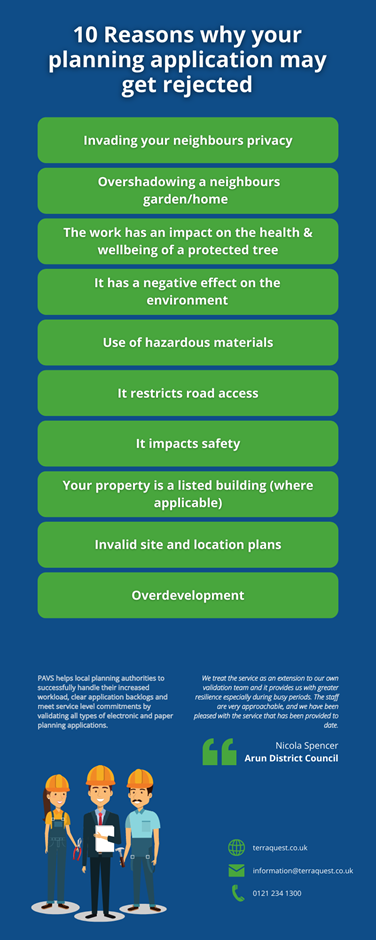
TerraQuest News
- Dec 2022
10 Reasons why your planning application may get rejected
There are many reasons why planning applications get rejected. Knowing why a planning application may get rejected will help you prevent prolonging the process so you can get on with your works.
Common Reasons Why Your Planning Permissions May Get Rejected
Below I have listed some of the common (but not all) reasons why your planning permission may be refused:
1. Loss of privacy
Will your development overshadow your neighbour's properties? This is one of the key things your planning department will consider, so you need to ensure that the development will not invade your neighbours privacy in any way.
2. Loss of light
If your build overshadows a neighbour garden/home and causes a loss of light, your application may be rejected. The impact your location has on its surroundings has a crucial role when it comes to your planning application being rejected.
3. It has an impact on trees
A TPO is a legal protection, afforded by a local council, covering an individual tree, a group of trees or a whole forest, preventing any work to prune, cut back or remove it. If your work has an impact on the health and wellbeing of a protected tree then your planning application will probably be rejected.
4. It has a negative effect on the environment
Does your proposal have a negative effect on the surrounding nature of the area? If so it will probably be rejected. Planning committees do not want people destroying nearby wildlife habitats and the environment.
5. Use of hazardous materials
The materials you choose for the development should not be a safety hazard. To avoid your planning application being rejected, ensure that you know about each of the materials that will be used in the project.
6. It restricts road access
If your proposal will restrict road access in any way, your application will likely be rejected. Access to your development in terms of road safety will be considered as part of the application.
7. It impacts safety
Any proposed development which could cause, for example, air pollution, unfit housing, or unhygienic food preparation premises would be the concern of environmental health officers (EHOs). You application may be rejected if the works has an impact on safety in anyway.
8. Your property is a listed building (where applicable)
Listed building consent is a type of planning control, which protects buildings of special architectural or historical interest. These controls are in addition to any planning regulations which would normally apply. Listed building status can also result in the requirement for planning permission where it wouldn’t ordinarily be required - for example, the erection of means of enclosure.
9. Invalid site and location plans.
A location plan needs to:
- be at the correct scale
- show the full address of the proposal.
- show us clearly the area relating to the proposal. We need you to outline the area with a red line. If you own any other land surrounding this, you should outline it in blue.
A block plan/site plan needs to:
- be at the correct scale
- show the full address of the proposal.
- show the buildings, adjacent streets, and any trees or ponds that may impact the proposal.
10. Overdevelopment
Overdevelopment refers to the 'amount of development' (e.g. the quantity of buildings or intensity of use) that is excessive in terms of demands on infrastructure and services' or 'impact on local amenity and character'.

TerraQuest's Planning Application Validation Service (PAVS) is designed to reduce the time and cost taken to validate planning applications while enhancing the applicant's experience. PAVS helps local planning authorities to successfully handle their increased workload, clear application backlogs and meet service level commitments by validating all types of electronic and paper planning applications.


